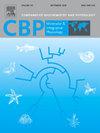Integrated analysis of antioxidant defense and energy metabolism in the gills of Sinonovacula constricta under hyposalinity stress
IF 2.2
3区 生物学
Q4 BIOCHEMISTRY & MOLECULAR BIOLOGY
Comparative Biochemistry and Physiology A-Molecular & Integrative Physiology
Pub Date : 2025-09-16
DOI:10.1016/j.cbpa.2025.111932
引用次数: 0
Abstract
Salinity has a significant impact on the growth, energy metabolism, and immune regulation of marine bivalves. To elucidate the response of marine bivalves to low salinity environments and their tolerance mechanisms, this study investigated histopathological alterations and measured oxidative stress indicators along with energy metabolism parameters in gill tissues of Sinonovacula constricta under hyposalinity stress (salinity 5). Transcriptomic profiling of gills from the control group (salinity 20) and low salinity group was concurrently analyzed. The results demonstrated that during the initial stress phase, the antioxidant defense system was activated, evidenced by significant increases in superoxide dismutase (SOD) and catalase (CAT) activities as well as total antioxidant capacity (T-AOC). Concurrently, elevated levels of reactive oxygen species (ROS) and malondialdehyde (MDA) indicated oxidative stress status. In the later stress phase, declined activities of antioxidant enzymes suggested severe oxidative damage. Throughout hyposalinity exposure, ATP content progressively decreased, while ATPase and pyruvate kinase (PK) activities exhibited an initial increase followed by reduction, reflecting elevated energy expenditure. Transcriptomic analysis identified 501 differentially expressed genes (DEGs) between low salinity and control groups. GO and KEGG enrichment analyses revealed significant enrichment of these DEGs in energy metabolism and protein synthesis-related processes, with notable enrichment in functional enzyme activities associated with the phosphatidylinositol signaling pathway in gills. This study systematically revealed the physiological response mechanisms of S. constricta to hyposalinity stress, and elucidated the roles of the phosphatidylinositol signaling pathway, amino acid metabolism, and endoplasmic reticulum protein processing in the adaptation of S. constricta to hyposalinity stress.

低盐度胁迫下缢蛏鳃抗氧化防御与能量代谢的综合分析。
盐度对海洋双壳类的生长、能量代谢和免疫调节有显著影响。为了阐明海洋双壳类动物对低盐度环境的响应及其耐受机制,本研究对低盐度胁迫(盐度5)下缢蛏鳃组织的组织病理学变化进行了研究,并测量了氧化应激指标和能量代谢参数。同时分析对照组(盐度20)和低盐度组的鳃转录组谱。结果表明,在胁迫初期,抗氧化防御系统被激活,超氧化物歧化酶(SOD)和过氧化氢酶(CAT)活性显著升高,总抗氧化能力(T-AOC)显著升高。同时,活性氧(ROS)和丙二醛(MDA)水平升高表明氧化应激状态。在胁迫后期,抗氧化酶活性下降,表明氧化损伤严重。在整个低盐暴露过程中,ATP含量逐渐降低,而ATP酶和丙酮酸激酶(PK)活性呈现出先升高后降低的趋势,反映了能量消耗的增加。转录组学分析发现,低盐度组与对照组之间存在501个差异表达基因(DEGs)。GO和KEGG富集分析显示,这些DEGs在能量代谢和蛋白质合成相关过程中显著富集,在鳃中与磷脂酰肌醇信号通路相关的功能酶活性中显著富集。本研究系统揭示了缢蛏对低盐度胁迫的生理反应机制,阐明了磷脂酰肌醇信号通路、氨基酸代谢和内质网蛋白加工在缢蛏适应低盐度胁迫中的作用。
本文章由计算机程序翻译,如有差异,请以英文原文为准。
求助全文
约1分钟内获得全文
求助全文
来源期刊
CiteScore
5.00
自引率
4.30%
发文量
155
审稿时长
3 months
期刊介绍:
Part A: Molecular & Integrative Physiology of Comparative Biochemistry and Physiology. This journal covers molecular, cellular, integrative, and ecological physiology. Topics include bioenergetics, circulation, development, excretion, ion regulation, endocrinology, neurobiology, nutrition, respiration, and thermal biology. Study on regulatory mechanisms at any level of organization such as signal transduction and cellular interaction and control of behavior are also published.

 求助内容:
求助内容: 应助结果提醒方式:
应助结果提醒方式:


